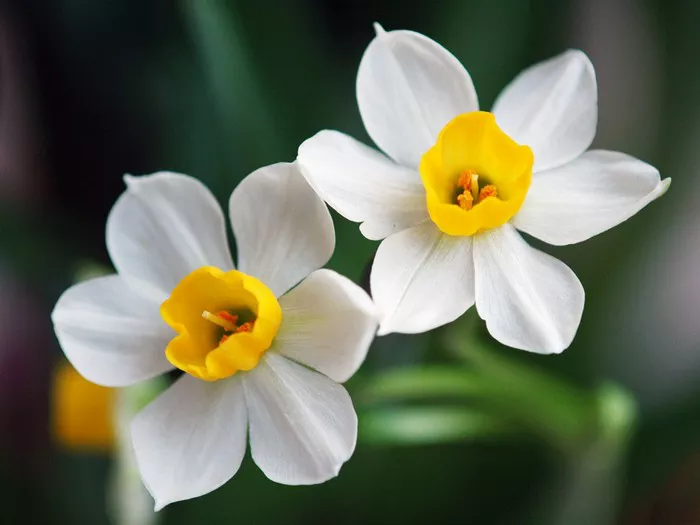Spring, with its resplendent hues and fragrant blooms, marks a time of rejuvenation and renewal in the natural world. As winter’s grasp loosens and the earth awakens from its slumber, an array of flowers burst forth, painting landscapes with vibrant colors. Among this floral symphony, one bloom stands out as a ubiquitous emblem of springtime: the daffodil.
Daffodils: A Symbol of Spring
Daffodils, scientifically known as Narcissus, are perennial flowers belonging to the Amaryllidaceae family. Originating primarily from Europe and North Africa, these charming blooms have become synonymous with the arrival of spring in many parts of the world. Characterized by their trumpet-shaped corona surrounded by six petals, daffodils exhibit a wide range of colors, including shades of yellow, white, orange, and pink.
Historical Significance and Cultural Importance
The history of daffodils dates back centuries, with cultural significance embedded in various mythologies and traditions. In Greek mythology, the flower is associated with the story of Narcissus, a handsome youth who fell in love with his own reflection and was transformed into the flower that bears his name. This tale reflects themes of vanity and self-love, adding a layer of symbolism to the daffodil’s beauty.
Throughout history, daffodils have also held practical significance. In ancient times, they were valued for their medicinal properties, believed to possess healing qualities for ailments ranging from wounds to respiratory issues. Additionally, daffodils have been cultivated for their bulbs, which contain alkaloids with potential insecticidal properties.
Botanical Characteristics and Growing Conditions
Understanding the botanical characteristics and ideal growing conditions is essential for cultivating daffodils successfully. These hardy flowers typically grow from bulbs, which are planted in the fall to allow for root development before spring emergence. Daffodils thrive in well-drained soil and prefer locations with ample sunlight, although they can tolerate partial shade.
Daffodils are known for their resilience and ability to naturalize, meaning they can spread and multiply over time without requiring extensive maintenance. This trait contributes to their prevalence in gardens, parks, and naturalized landscapes, where they create striking displays year after year.
Varieties of Daffodils: Exploring Diversity
The genus Narcissus encompasses a vast array of species and cultivars, offering a diverse selection of daffodils to suit different preferences and growing conditions. Some popular varieties include:
1. Trumpet Daffodils: Characterized by a prominent trumpet-shaped corona, these daffodils often feature vibrant yellow or white petals.
2. Large-Cupped Daffodils: Known for their large central cups, these daffodils exhibit a wide range of colors and patterns, adding visual interest to garden beds.
3. Small-Cupped Daffodils: With smaller coronas that are less than one-third the length of the petals, these daffodils offer a delicate charm and come in various hues.
4. Double Daffodils: These cultivars feature multiple layers of petals, giving them a fuller appearance and a distinctive, ruffled texture.
5. Jonquilla Daffodils: Smaller in size with fragrant blooms, jonquilla daffodils add a delightful scent to spring gardens and are often used for naturalizing in meadows or woodland areas.
Each daffodil variety brings its own unique characteristics to the landscape, contributing to the overall tapestry of springtime beauty.
Cultural Practices and Care Tips
To ensure the health and vitality of daffodils, proper care and maintenance practices are essential. Here are some tips for cultivating these beloved spring flowers:
1. Planting: Choose a location with well-drained soil and sufficient sunlight. Plant bulbs in the fall at a depth of about twice their diameter, spacing them several inches apart to allow for adequate airflow and growth.
2. Watering: While daffodils require regular watering during their active growth phase, they are susceptible to rot if the soil becomes waterlogged. Water deeply but infrequently, allowing the soil to dry out between waterings.
3. Fertilization: Apply a balanced fertilizer in the spring as new growth emerges to provide essential nutrients for healthy blooms. Avoid excessive fertilization, as this can lead to lush foliage at the expense of flower production.
4. Deadheading: Remove spent flowers to prevent seed formation and encourage the plant to redirect its energy towards bulb development. Allow the foliage to die back naturally after flowering to replenish the bulb for the following year.
5. Division: Every few years, divide overcrowded clumps of daffodils to maintain vigor and prevent overcrowding. Lift the bulbs after the foliage has withered and replant them at the appropriate depth.
By following these cultural practices, gardeners can enjoy a bountiful display of daffodils year after year, enriching their outdoor spaces with the beauty of spring.
Environmental Significance and Ecological Impact
Beyond their ornamental value, daffodils play a vital role in supporting biodiversity and ecosystem health. As early spring bloomers, they provide a crucial food source for pollinators such as bees and butterflies, aiding in their survival and contributing to the pollination of other plants. Additionally, daffodils help stabilize soil and prevent erosion, making them valuable components of sustainable landscaping practices.
However, it’s essential to recognize that daffodils, like many introduced species, can have unintended ecological consequences when grown in non-native habitats. In some regions, daffodils have escaped cultivation and become invasive, outcompeting native vegetation and disrupting fragile ecosystems. Therefore, it’s crucial to exercise caution when planting daffodils in areas where they may pose a threat to native flora and fauna.
Conclusion
In conclusion, the daffodil stands as a quintessential symbol of spring, heralding the arrival of warmer weather and new beginnings. From their historical and cultural significance to their diverse array of varieties and ecological importance, daffodils captivate hearts and minds around the world.
As gardeners and nature enthusiasts alike embrace the splendor of spring, let us pause to appreciate the enduring beauty of these enchanting flowers and the joy they bring to our lives. Whether adorning garden beds, lining pathways, or brightening indoor spaces with cut blooms, daffodils continue to inspire wonder and admiration, reaffirming their status as the most common flower of the season.


